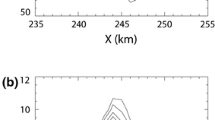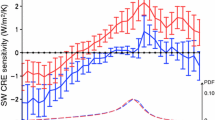Summary
A conceptually simple model based on cloud geometry is proposed to explain direct adjustment of moisture by convective clouds. The model is tested using deep convective cloud geometry and changes in upper tropospheric humidity in the Tropical Western Pacific (TWP) during TOGACOARE. The model and the data emphasize the importance of clouds larger than a General Circulation Model (GCM) grid box in drying the upper topospheric environment and in sub grid scale clouds in moistening the upper topospheric environment. The convective cloud sizes and changes in moisture are shown to be linked to precipitation rates. The change from clouds that moisten to clouds that dry the environment occurs when the average cloud size in 6.8×104 km2 or rain rate of 2.1 mm hr−1. In a study of moisture change in the sub cloud layer due to convection, Barnes and Garstang (1982) demonstrated that precipitation rates greater than 2 mm hr−1 resulted in drying. The critical rain rates above which environmental drying occurs is similar for both upper tropospheric regions and the sub cloud. The similarity of the rain rates indicates that the model concepts maybe used to explain direct adjustment of moisture under a variety of conditions.
Similar content being viewed by others
References
Arakawa, A., Schubert, W.H., 1974: Interaction of a Cumulus Cloud ensemble with large scale environment, Part I.J. Atmos. Sci.,31, 674–701.
Arakawa, A., 1993: Closure Assumptions in the cumulus parameterization problem. In: Emanuel, K. A., Raymond, D. J. (eds.)The Representation of Cumulus Convection in Numerical Models. 24. Boston, MA: American Meteorological Society, pp. 246.
Barnes, G., Garstang, M., 1982: Subcloud layer energetics of precipitating convection.Mon. Wea. Rev.,110, 102–117.
Betts, A. K., 1973: Non Precipitating cumulus convection and its parameterization.Quart. J. Roy. Meteor. Soc.,99, 178–196.
Betts, A. K., Miller, M. J., 1986: A new convective adjustment scheme I. Observational and theoretical basis.Quart. J. Roy. Meteor. Soc.,112, 677–691.
Bretherton, C. S., Smolarkiewicz, P. K., 1989: Gravity waves, compensating subsidence and detrainment around cumulus clouds.J. Atmos. Sci.,46, 740–759.
Chalan, R. F., Joseph, J. H., 1989: Fractal statistics of cloud fields.Mon. Wea. Rev.,117, 261–272.
Emanuel, K. A., 1991: A scheme for representing cumulus convection in large scale models.J. Atmos. Sci.,48, 2313–2335.
Emanuel, K. A., 1994:Atmospheric Convection. New York: Oxford University Press.
Frank, W.M., 1983: The cumulus parameterization problem.Mon. Wea. Rev.,111, 1859–1871.
Frank, W. M., Cohen, M., 1987: Simulation of tropical convection layers. Part I: A cumulus parameterization.J. Atmos. Sci.,44, 3464–3478.
Fritsch, J. M., Chappell, C. F., 1980: Numerical prediction of convectively driven mesoscale pressure systems: Part I: Convective parameterization schemes.J. Atmos. Sci.,37, 1722–1733.
Fu, R., Del-Genio, A. D., Rossow, W. B., 1990: Behaviour of deep convective clouds in the tropical pacific deduced from ISCCP radiances.J. Climate,3, 1129–1153.
Gill, A. E., 1982:Atmosphere-Ocean Dynamics. (International Geophysics Series. 30). San Diego: Academic Press.
Gray, W. M., 1973: Cumulus convection and larger scale circulations. I: Broadscale and mesoscale considerations.Mon. Wea. Rev.,101, 839–855.
Jackson, D. L., Stephens, G. L., 1995: A study of SSM/I-derived columnar water vapor over the global oceans.J. Climate,8, 2025–2038.
Johnson, R. H., 1977: The effects of cloud detrainment on the diagnosed properties of cumulus populations.J. Atmos. Sci.,34, 359–366.
Knupp, K. R., Cotton, W. R., 1985: Convective cloud downdraft structure: an interpretive survey.Rev. Geophys.,23, 183–215.
Liu, G., Curry, J. A., Sheu, R.-S., 1995: Classification of clouds over the western equatorial Pacific Ocean using combined infrared and microwave satellite data.J. Geophys. Res.,100, 13811–13826.
Lord, S. J., 1982: Interaction of a cumulus cloud ensemble with the large scale environment. Part III: Semiprognostic test of the Arkawa-Schubert cumulus parameterizationJ. Atmos. Sci.,39, 88–103.
Machado, L. A. T., Rossow, W. B., 1993: Structure, characteristics and radiative properties of tropical cloud clusters.Mon. Wea. Rev.,121, 3234–3260.
Mapes, B., Houze, B. E., 1993: Cloud clusters and super clusters over the Oceanic warm pool.Mon. Wea. Rev.,121, 1398–1415.
Meteorological-Research-Institute, 1993: GMS-4 Infrared Images over the TOGA-COARE Region. Tokyo, Japan, Japan meteorological Agency and Science and Technology Agency. 8.
Ooyama, V. K., 1971: A theory on parameterization of cumulus convection.J. Meteor. Soc. Japan,49, 744–756.
Parsons, D., Dabberdt, W., Coloe, H., Hock, T., Martin, C., Barrett, A.-L., Miller, E., Spowart, M., Howard, M., Ecklund, W., Carter, D., Gage, K., Wilson, J., 1994: The integrated sounding system: description and orelimnary observations from TOGA-COARE.Bull. Amer. Meteor. Soc.,75, 553–567.
Perry, K. D., Hobbs, P. V., 1996: Influences of isolated cumulus clouds on the humidity of their surroundings.J. Atmos. Sci.,53, 159–174.
Raga, G. B., Jensen, J. B., Baker B. M., 1990: Characteristics of cumulus bands of clouds off the coast of Hawaii.J. Atmos. Sci.,47, 338–355.
Raymond, D. J., 1993: Observational constraints on Cumulus Parameterizations. In: Emanuel, K. A., Raymond, D. J. (eds.)The Representation of Cumulus Convection in Numerical Models. 24. Boston, MA: American Meteorological Society, pp. 17–28.
Raymond, D. J., Blyth, A. M., 1986: A stochastic mixing mixing model for non precipitating cumulus clouds.J. Atmos. Sci.,43, 2708–2718.
Simpson, J., Van-Helvoirt, G., Mcumber, M., 1982: Three dimensional simulations of cumulus congestus clouds on GATE day 261.J. Atmos. Sci.,39, 126–145.
Sheu, R.-S., Liu, G., 1995: Atmospheric humidity variations associated with westerly wind bursts during Tropical Ocean Global Atmosphere (TOGA) Coupled Ocean Atmosphere Response Experiment (COARE).J. Geophys. Res.,100, 25,759–25,768.
Walcek, C. J., Hu, Q., Iacovazzi, B., 1994: Cumulus clouds parameterized as detraining plumes. AMS 10th Conference on Numerical Weather Prediction, Portland, Oregon, American Meteorological Society, pp. 77–78.
Weller, R. A., Anderson, S. P., 1996: Surface meteorology and air-sea fluxes in the western equatorialPacific warm pool during the TOGA Coupled Ocean-Atmosphere Response Experiment.J. Climate,9, 1959–1990.
Yanai, M., Johnson, R. H., 1993: Impacts of cumulus convection on thermodynamic fields.Meteorological Monographs,24, 39–62.
Yanai, M., Esbensen, S., Chu, J. H., 1973: Determination of bulk properties of tropical cloud clusters from large scale heat and moisture budgets.J. Atmos. Sci.,30, 611–627.
Walcek, C. J., Hu, Q., Iacovazzi, B., 1994: Cumulus clouds parameterized as detraining pulmes.AMS 10th Conference on Numerical Weather Prediction, Portland, Oregon, American Meteorological Society, pp. 77–78.
Zipser, E. J., 1969: The role of organized unsaturated convective downdrafts in the structure and rapid decay of an equatorial disturbance.J. Climate Appl. Meteor.,8, 799–814.
Author information
Authors and Affiliations
Additional information
With 12 Figures
Rights and permissions
About this article
Cite this article
Barr-Kumarakulasinghe, S.A., Lwiza, K.M.M. Deep convective cloud scales and direct adjustment of upper troposphere moisture in TWP environment. Meteorl. Atmos. Phys. 66, 35–50 (1998). https://doi.org/10.1007/BF01030447
Received:
Revised:
Issue Date:
DOI: https://doi.org/10.1007/BF01030447




